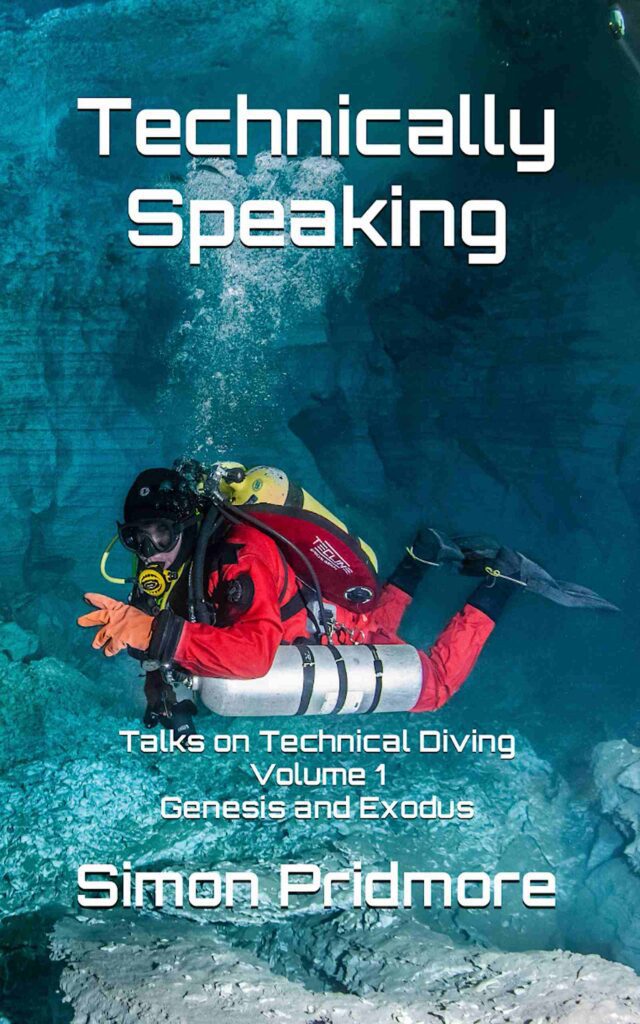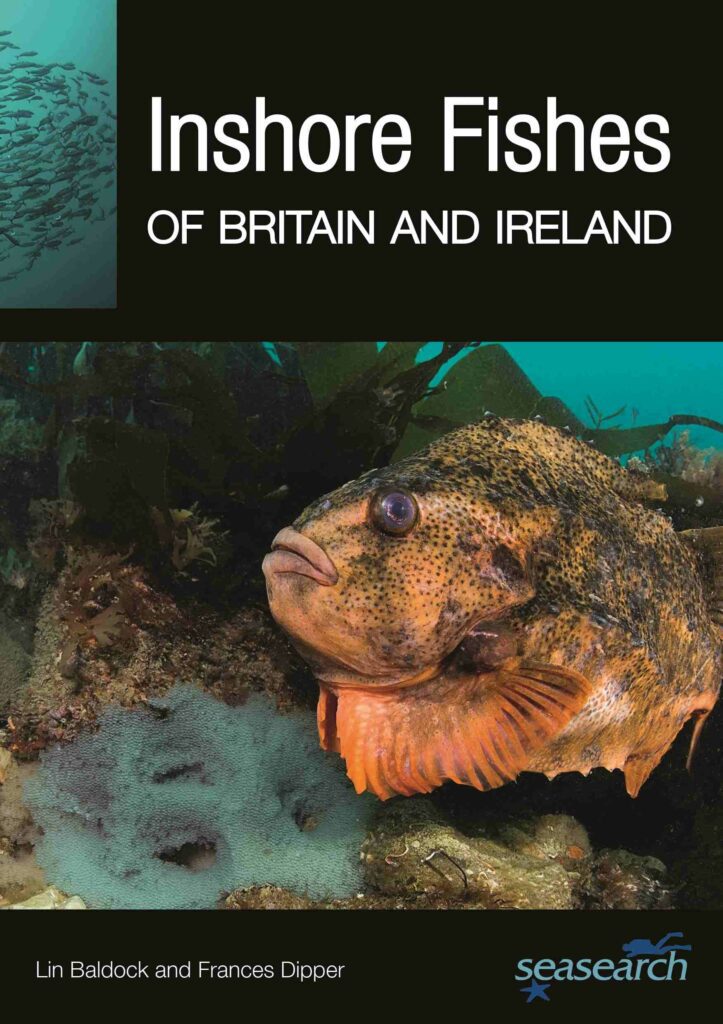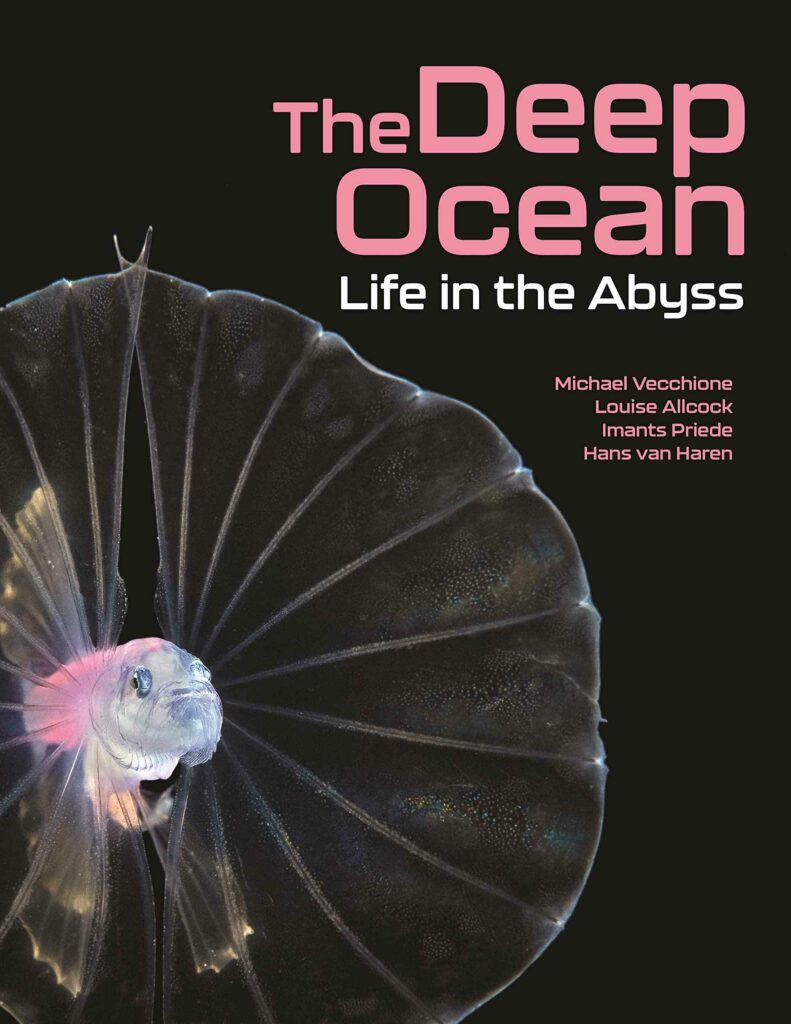- 1) Technically Speaking – Talks On Technical Diving Vol 1: Genesis and Exodus, by Simon Pridmore
- 2) Inshore Fishes Of Britain And Ireland, by Lin Baldock & Frances Dipper
- 3) What Lies Beneath: My Life As A Forensic Search And Rescue Expert, by Peter Faulding
- 4) The Deep Ocean: Life In The Abyss, by Michael Vecchione, Louise Allcock, Imants Priede & Hans van Haren
- 5) The Weird And Wonderful World Of Marine Worms, Tropical Indo-Pacific, by Andrey Ryanskiy
Technically Speaking – Talks On Technical Diving Vol 1: Genesis and Exodus, by Simon Pridmore

You’ll know that Divernet gives this book the big thumbs-up from the fact that we have already posted a taster extract – How Technical Diving Spread Around The World – to encourage you to give it a try.
Technically Speaking is a selection of “talks” by one of scuba’s very best writers, each one covering a theme such as nitrox, rebreathers or PO2 and overlapping just enough for each to remain self-contained. The format was inspired by technical-diving presentations Pridmore has given over the years, although he says 95% of the chapters are new talks.
Essentially this is the first of three chronicles, leading us gently from 1989 through the 1990s to explore the origins and development of tech diving. The movement began in the USA with Florida’s cave-divers and the North-east’s wreck-divers. but soon caught the attention of experimentally minded divers elsewhere in the world, not least in the UK.
British diver Simon Pridmore became an intrinsic part of the movement. In the ’90s he was pioneering mixed-gas deep diving in Asia, ran the first dedicated technical dive-centre in the western Pacific and held the regional franchise for IANTD.
Although there was certainly an element of elitism and protectionism about the original technical divers, who were learning more with every extreme dive – and sometimes fatality – ultimately they knew they could protect themselves from undue official interference in only one way. That was to share their knowledge to make the sport as safe as possible for those who came to follow in increasing numbers. And there were a lot of interesting bumps along that road.
When I started diving in the early ’90s people were still referring to nitrox as “devil gas” and rebreathers were about to attract the “box of death” slur that came to dog them. This book constantly surprised me by filling in so many yawning gaps in my knowledge, though that probably won’t be the case for hardcore technical divers.
While it’s been only 34 years, for technical divers the names of the prime movers – Stone, Deans, Gilliam, Mount, Exley, Watts and all the rest – have long attained a sort of “wild west” status. “Ultimately, success came down to perseverance, people power, good timing and more than a little luck,” says the author.
Chronicling this decade of uneven expansion with the benefit of his insider knowledge – and both hindsight and insight – makes for a read that flies by. So much of what those pioneers achieved has filtered down into everyday sport diving, and you really won’t need to be a technical diver to enjoy it.
Sandsmedia, ISBN: 9798375190792
Paperback, 348pp, 13x20cm, £14.99 (Kindle £5.99, hardback £19.99)
Inshore Fishes Of Britain And Ireland, by Lin Baldock & Frances Dipper

Seasearch is the Marine Conservation Society’s species-recording programme for volunteer divers, and this new book slots into a series of Seasearch-branded reference books covering various aspects of British Isles marine life.
It could be invaluable for divers – perhaps even those who already possess classics such as Paul Naylor’s Great British Marine Animals or Frances Dipper’s own British Sea Fishes, which has been around since the pre-digital 1980s.
Inshore Fishes should cover all but the most unusual “vagrant” underwater sightings and help avoid the sort of confusion between similar fish that can occur, especially when they’re glimpsed in low-vis conditions. It contains more than 150 species and goes into a fair amount of detail about their appearance, behaviour, distribution and so on.
The underwater photographs are high-quality, dished out generously and come from a variety of respected sources, including co-author Lin Baldock. There are also the usual fine illustrations from Marc Dando, so we’re in good hands here.
Everything has been thought through with the benefit of the authors’ long experience, their mission to prevent diver ID frustration. Attractively produced and printed on matt paper with usefully designed cover-flaps, this should be a book to treasure – even when, further down the line, it is reduced to a dog-eared existence in the club-van’s glovebox.
Princeton University Press, ISBN: 9780691249018
Paperback, 288pp, 14x21cm, £22
What Lies Beneath: My Life As A Forensic Search And Rescue Expert, by Peter Faulding

I wouldn’t have thought to read this book but for the coincidence that it was published in early February, just as Peter Faulding was hitting UK news headlines for his part in the river-search for missing estate-agent Nicola Bulley.
After his private dive-team’s failure to find the missing woman following some perhaps ill-considered remarks to the press, and her body’s subsequent discovery in a riverside reedbed, Faulding was the focus of something of a public backlash. Had he seen the perfect opportunity to draw attention to his autobiography by trying to showcase his expertise on such a national stage?
I can’t say, but I’m glad I read this book because Faulding turns out to be a fascinating man and his story was well worth getting down on paper. I don’t doubt that he has a good opinion of himself and his very particular set of skills – you don’t write your memoirs if you don’t – but his career has certainly left him with plenty of colourful material.
Two big takeaways come early on: at the age of five Peter was being sent down into tight subterranean shafts by his caving father and friends because he was small enough to scope them out, conjuring grim visions of Victorian chimney-sweeps. Also, as a big Thunderbirds TV puppet-show fan, he harboured early fantasies of organising his own version of International Rescue.
He even later called his company Specialist Group International (SGI), though it doesn’t seem to operate beyond UK shores, but it did possess much of the sophisticated hardware and cutting-edge expertise Faulding had dreamt of as a child. Among other things he claims to have introduced sidescan sonar to underwater search and recovery activities in the UK.
The revelations about his early years underground become less shocking as we realise how at home Faulding has always felt in confined spaces. As an adult, voluntary assistance for the emergency services turned into a career as he started being called in to deal with a generation of development protestors – like the famed Swampy – who were devising ever more suicidal ways of locking themselves in place underground.
Putting the justness of their cause aside, by Faulding’s own account he seems to have saved a fair few lives through his patient and compassionate approach to extricating them.
The former paratrooper learnt to fly helicopters and planes, and SGI was increasingly called in by the police when it came to searching for buried or sunken bodies or evidence. Many of the cases were notorious, and sometimes success could be measured by what failed to be found.
Faulding mentions learning to scuba dive early in the book, but it is only relatively late on, with police forces disbanding so many of their own dive-teams, that his diving activities come to the fore.
In one shocking passage, he relates how police officers apparently bitter about having to rely on outsiders impede SGI’s recovery of a body from a river, even as distraught relatives plead for the team to be allowed to go in.
In another, Faulding describes being told there is no need to search a section of river because it has already been covered. When he insists, it turns out that the police had used volunteers equipped with a cheap fish-finder, and he quickly finds the missing person. It provides interesting background to his involvement in the Bulley case.
Faulding’s real-life “International Rescue” was suspended from the UK National Crime Agency’s list of experts for review soon after the Bulley search, and I have no idea what lay behind that decision. But the man does seem to have much to be proud of in terms of skills and enterprise, lives saved, closure brought and, not least, his water-safety charity work.
Even though diving is only a part of his unusual story, this well-written book is worth a read.
Pan Macmillan, ISBN: 9781035005901
Hardback, 294pp, 16x24cm, £18.99 (Kindle £9.99)
The Deep Ocean: Life In The Abyss, by Michael Vecchione, Louise Allcock, Imants Priede & Hans van Haren

Time for a real coffee-table book, one to dip into whenever you feel like plunging far beyond where scuba can take you. This, like Inshore Fishes above, is an offering from Princeton University Press, which has form in producing attractively produced books for divers to enjoy.
The authors are zoologists from the Smithsonian and Universities of Galway and Aberdeen, while van Haren is an oceanographer at the Royal Netherlands Institute for Sea Research. Their tone is scientific but always accessible, so it depends on how much deep information you want or need – the contents feel comprehensive – but for many of us it’s the photography that will be the main attraction.
Much of the illustration consists of spectacular blackwater shots of enjoyably alien deep-dwelling creatures such as vampire squid, dragonfish or the nightmarish black swallower, and the authors provide the deep background on what we’re seeing in pleasantly readable style. The graphics are superb too, in terms of both design and content.
After the introduction the book is divided into sections on oceanography, deep-sea organisms, habitats, global patterns and “humanity and the deep oceans” – the obligatory depressing closing section we have come to expect in today’s books about the seas.
This details all the damage we humans are inflicting on the unseen deeps, which had once been considered vast enough to be inviolate – you name it, oxygen-depletion, increased temperatures, acidity, chemical pollution, plastics, shipwrecks, the ransacking of fish through deep trawls – millions of tons of blue whiting alone – and extraction of petrochemicals and minerals. If this attractive book can provide any further ammunition against this creeping devastation, good on it.
Princeton University Press, ISBN: 9780691226811
Hardback, 288pp, 22x28cm, £35 (Kindle £34.82)
The Weird And Wonderful World Of Marine Worms, Tropical Indo-Pacific, by Andrey Ryanskiy

Marine worms really can be weird. I’m still haunted by my first sight of a towering Bobbit worm emerging ominously out of nowhere at a gloomy muck-site in the Bali Sea.
This is the latest and, I’m told, penultimate in the Reef ID book series, in paperback or (best for travelling) e-form. It was only last Christmas that we covered the arrival of the previous book, on Red Sea marine life, which one might expect to have wider appeal.
Not too many divers might be desperate for a photo-guide dedicated to Indo-Pacific (including the Red Sea) marine worms but it must be the first of its kind, and there will certainly be underwater photographers to appreciate its existence and the hard work that has gone into it. The author is also offering Divernet readers a special discount (see below).
It’s another brick in the wall – if you buy all seven books in the Reef ID Travel Set you have a reference covering more than 7,200 Indo-Pacific species of nudibranchs, living seashells, crustaceans, fishes, echinoderms, flatworms and now worms. Incredibly, the author tells me that he took 75% of the photos in this new offering himself – he rarely seems to rest.
The new addition contains, in the now-familiar style, some 440 species shown in around 820 colour photos, with care taken to overcome confusion with colour variations – for certain species as many as 10 photos were added for this purpose. Ryanskiy reckons that live photos of most of the species have never appeared in guides before. The text is, as ever, concise.
The final book in the series will cover sedentary marine invertebrates – the corals, sponges, ascidians, bryozoans and comb jellies. Question is, will Ryanskiy then take a well-earned break?
Reef ID Books, ISBN: 9798986828725
Paperback, 90pp, 15x23cm, US $26 (Kindle $15.99, hardback $33.99)
NOTE: Divernet readers using this link can buy a copy of this Reef ID book with a 20% discount!
More book reviews on Divernet: Feb 23, Dec 22, Aug 22, Apr 22

